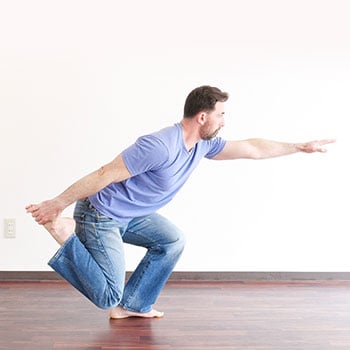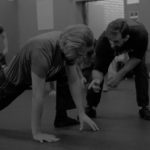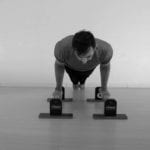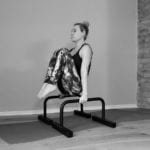I know how hard it can be to get your workouts in.
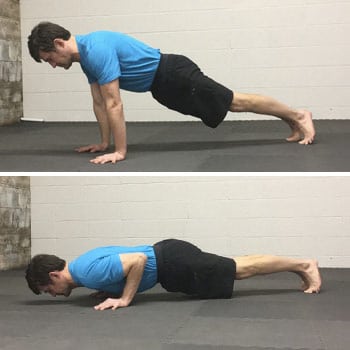 Between family and work responsibilities and the inevitable, out-of-the-blue emergencies that can pop up during your designated training time, it’s practically a miracle when you can get in one good training session in a week, let alone three or four.
Between family and work responsibilities and the inevitable, out-of-the-blue emergencies that can pop up during your designated training time, it’s practically a miracle when you can get in one good training session in a week, let alone three or four.
Some fitness enthusiasts shout platitudes like “You just need to make the time!” or “You just don’t want it badly enough!”
But it’s not about that at all (and frankly, those people are just jerks).
The challenges of staying consistent with a training program are very real, but your progress shouldn’t be derailed just because your life gets busy and you can’t keep up with your regular training.
So, in this article, I’ll share a simple formula for getting a quick workout in, even if you’re short on time.
Our free Strength and Mobility Kickstart is a great way to see how to apply the formula you learned in this article to a more comprehensive program that is helping you work toward your goals.
Exercise Consistency Beats Quantity Any Day
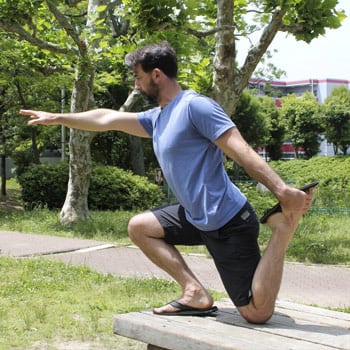 We’ve always emphasized the benefits of following a well-structured training program. The right program that aligns well with your goals can help you make faster progress while removing a lot of the guesswork.
We’ve always emphasized the benefits of following a well-structured training program. The right program that aligns well with your goals can help you make faster progress while removing a lot of the guesswork.
So, let’s say you’ve started on a program that really matches what you’re looking to get out of your training right now.
And things are going well!
Week 1 is tough, but you get in all your planned training sessions. In week 2, you start to find your rhythm and feel more comfortable with things.
Then, midway through week 3, your daughter comes down with the flu and you have to stay home from work to take care of her. There’s no way you can get in an hour-long training session. A couple of days later, you get stuck in really bad traffic on your way home, and there goes your planned workout. Again.
This is where most people give up altogether, and it’s a very common trap to fall into.
You think that if you can’t do your workout as planned, then there’s no point in doing it at all. And if you can’t do your program as planned, then you might as well stop, and try again in some utopian future in which you’re not as busy as you are now.
But it doesn’t have to be all or nothing.
You’ll have a much better shot at achieving your goals if you do something consistently, as opposed to doing something perfect infrequently.
So, when you don’t have time for your planned workout, instead of giving up altogether, just showing up and doing something–even if it’s only a few minutes of work–will do wonders for your overall progress toward your goals. Let’s see what that looks like.
How to Build a Simple & Quick Bodyweight Workout Plan When You’re Short on Time
No matter what program you’re currently following, it’s a good idea to have a quick workout in your back pocket, that’s geared toward your same basic goals and can replace your planned training session if something comes up.
That way, you’re still working toward your goals and staying consistent, even when you don’t have time for a 45-minute or hour-long session. Just showing up and making that a consistent habit is half the battle. The formula I’m about to share will help you keep showing up.
We design all of our training programs around what we call the 5Ps of programming:

Though play is an essential part of our approach to training, for the purposes of building a quick workout to accomplish a specific goal, we’ll just focus on the other four. Here’s the basic template:
| Prepare | Start with 2-3 movements to prepare your body for the specific work ahead. |
| Practice | Set a specific amount of time (5-10 minutes, depending on how much time you have that day) to practice the skill you are working toward, at whatever progression of the skill you're currently comfortable with. |
| Push | Next, you'll drop down to a level or two below your comfort level (to an easier variation of the skill you're working toward), and ramp up your intensity level. |
| Ponder | Even though this was a quick workout, take just two minutes at the end of the session to reflect on how things went and maybe make a couple of notes on what you should focus on in your next session. |
The idea is to trim the fat, so to speak, and focus on the most essential parts of a successful training session, so that even when you’re short on time, you’re still working toward your goals.
A quick training session should include targeted prep work, some skills practice, a bit of focused conditioning work, and a few minutes of mindful reflection. The exact amount of time you spend on each of these areas will depend on how much time you have on a given day.
If you have only 10 minutes one day, you can adjust the times to fit that. If you have more time, great!
Samples of Simple 20-Minute Home Bodyweight Workouts
You’re probably wondering how this looks in action. In the following video I’m going to show you two examples of quick workouts based on different skills. Of course, you may be working on entirely different skills, but the formula can still be applied.
Our free Strength and Mobility Kickstart is a great way to see how to apply the formula you learned in this article to a more comprehensive program that is helping you work toward your goals.
The workouts demonstrated for the the two example skills are:
Example Skill #1: Inverted Press
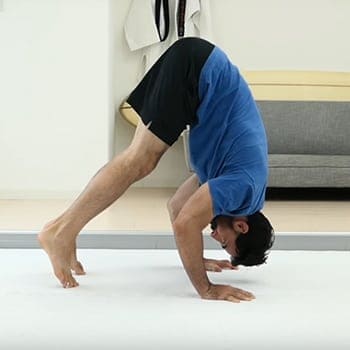
- Prepare–Wrist Extension/Flexion in Quadruped, and Bent Arm Chest Stretch
- Practice–Inverted Press Elevated
- Push–Push-Up
- Ponder–2 minutes of reflection
Example Skill #2: Shrimp Squat
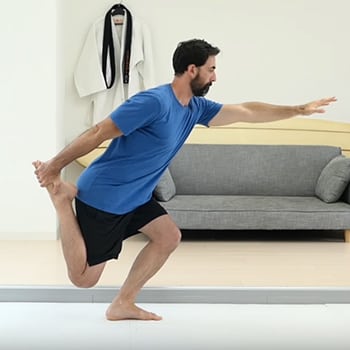
- Prepare–Kneeling Lunge, and Hip Circles
- Practice–Shrimp Squat Holding Foot
- Push–Shrimp Squat Freefloating Foot
- Ponder–2 minutes of reflection
As you can see, each sample workout is geared toward a particular skill, with each part of the session tailored to fit that goal. Whatever skills you’re working on, you can tailor even a short workout so that it’s helping you toward those goals.
And then, even if you replace your regular training session with this workout for a session or two or three, you can pick right back up where you left off with your regular training program.
When All Else Fails, Remember Your Why
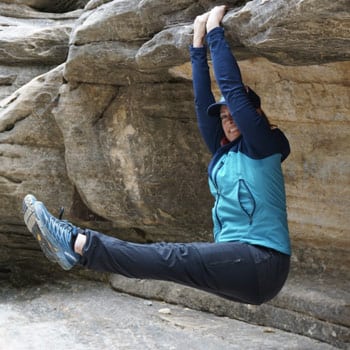 I love exercise and training, and I’m lucky that it’s part of my career and that I get to share my experience with you.
I love exercise and training, and I’m lucky that it’s part of my career and that I get to share my experience with you.
The discipline to make small gains add up to big changes over months and years, which means a lot to me. But, at the same time, it’s not simply the act of working out that motivates me.
I train because it improves me both physically and mentally for what’s important for me in my life.
Playing with my children freely and easily, being able to take long strenuous hikes out in nature, and just being physically healthy and ready for anything–these are my priorities.
And it’s my consistent training regimen that makes these priorities possible.
My fitness creates the life I am leading. It goes beyond body composition or even strength just for the sake of it. It’s helpful to remember that.
Your passion and zeal for improving yourself physically should have at its root something more than just those physical changes. Training becomes part of what you do because it supports who you are and what you want to be.
Support the Life You Have with Your Training
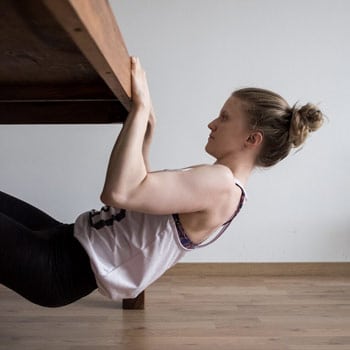 Being busy is a part of life for 99% of adults. You’ve got all sorts of responsibilities calling for your attention, but as you’ve seen in this article, your busy life doesn’t have to get in the way of your training goals.
Being busy is a part of life for 99% of adults. You’ve got all sorts of responsibilities calling for your attention, but as you’ve seen in this article, your busy life doesn’t have to get in the way of your training goals.
Consistency doesn’t mean you have to train exactly as you planned every time. It just means showing up consistently and doing what you can.
Along with the formula you just learned for building a quick workout when you need it, the best way to support your training goals is, well, to make sure you’re following a program that’s helping you toward those goals.
It may sound obvious, but many people struggle with finding the right program for their needs.
Our Integral Strength course is a well-structured program that will help you make fast progress toward the most common bodyweight strength training goals. But it’s flexible enough that you can work it into your busy and ever-changing life.
Build Strength for Physical Skill and Mastery
Over eight weeks, Integral Strength will help you build the kind of strength that carries over into demanding physical skills and dynamic sports.
Got something to say? Join the discussion over on Facebook.

